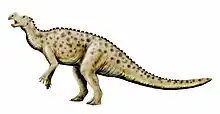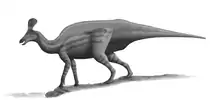Fylax
Fylax (meaning "keeper") is a genus of hadrosauroid ornithopod from the Late Cretaceous Figuerola Formation of Spain. The genus contains a single species, Fylax thyrakolasus, known from a nearly complete left dentary.[1]
| Fylax Temporal range: Late Cretaceous, | |
|---|---|
 | |
| Holotype dentary from multiple angles | |
| Scientific classification | |
| Domain: | Eukaryota |
| Kingdom: | Animalia |
| Phylum: | Chordata |
| Clade: | Dinosauria |
| Clade: | †Ornithischia |
| Clade: | †Ornithopoda |
| Clade: | †Hadrosauromorpha |
| Genus: | †Fylax Prieto-Márquez & Carrera Farias, 2021 |
| Species: | †F. thyrakolasus |
| Binomial name | |
| †Fylax thyrakolasus Prieto-Márquez & Carrera Farias, 2021 | |
Discovery and naming
The holotype of Fylax, IPS-36338, a left dentary, was discovered in the early 1990s. It was found in the Figuerola Formation in Lleida province, northeastern Spain. It was initially described in 1999.[2]
In 2021, Albert Prieto-Márquez and Miguel Ángel Carrera Farias described the dentary as belonging to a new genus of hadrosauroid dinosaur. The generic name, Fylax, comes from the modern Greek, fýlax (keeper), and the specific name, thyrakolasus, comes from the Greek thýra (gate) and kólasi (hell), thus creating the combination "keeper of the gates of hell” in reference to the proximity of this taxon to the Cretaceous-Paleogene mass extinction event.[1]
Classification
Prieto-Márquez and Carrera Farias recover Fylax as the sister taxon to Tethyshadros, in a derived position in the Hadrosauromorpha, making it one of the latest surviving non-hadrosaurid hadrosauromorphs. Their cladogram is shown below:
| Hadrosauromorpha |
| ||||||||||||||||||||||||||||||||||||||||||||||||||||||||||||||||||||||||||||||||||||
References
- Prieto-Márquez, Albert; Carrera Farias, Miguel (2021). "A new late-surviving early diverging Ibero-Armorican duck-billed dinosaur and the role of the Late Cretaceous European Archipelago in hadrosauroid biogeography". Acta Palaeontologica Polonica. 66. doi:10.4202/app.00821.2020.
- Casanovas, M.L., Pereda Suberbiola, X.P., Santafé, J.V., and Weishampel, D.B. 1999. "A primitive euhadrosaurian dinosaur from the uppermost Cretaceous of the Ager syncline (southern Pyrenees, Catalonia)". Geologie en Mijnbouw 78: 345–356







